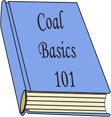|
|
| |
| Learn More About Coal! |
Visit our Coal Basics 101 page to learn about coal use in the energy industry. |
 |
|
|
|
|
|
|
| |
Question: To what country does the U.S. export the most coal?
|
|
|
| Back to Top |
| |
Question: From what country does the U.S. import the most coal?
|
|
|
| Back to Top |
| |
Question: What are the different types of coal prices?
|
|
|
|
| Back to Top |
| |
Question: Which state produces the most coal?
|
|
In 2007, Wyoming produced the most coal, mining 453.6 million short tons. |
| Coal
production by State |
| Last updated: October 3, 2008 |
|
|
| Back to Top |
| |
Question: How large are U.S. coal reserves?
|
U.S. coal reserves involve three separate components: |
 |
Recoverable coal reserves at producing mines |
 |
Estimated recoverable reserves |
 |
Demonstrated reserve base |
Recoverable coal reserves at producing mines represent the quantity of coal that can be recovered (i.e. mined) from existing coal reserves at reporting mines. These reserves essentially reflect the working inventory at producing mines. In 2007, the recoverable coal reserves in the United States totaled 18,584 million short tons at producing (active) mines.
The estimated recoverable reserves include the coal in the demonstrated reserve base (see below) considered recoverable after excluding coal estimated to be unavailable due to land use restrictions or currently economically unattractive for mining, and after applying assumed mining recovery rates. See the EIA Glossary for criteria. In 2007, the estimated recoverable reserves totaled 262,689 million short tons.
The demonstrated reserve base is composed of coal resources that have been identified to specified levels of accuracy and may support economic mining under current technologies. The demonstrated reserve base includes publicly-available data on coal that has been mapped and verified to be technologically minable. See the EIA Glossary for criteria. For 2007, the demonstrated reserve base was estimated to contain 489,395 million short tons. |
|
| Coal reserves by state |
| Last updated: November 6, 2008 |
|
|
| Back to Top |
| |
Question: What is the average heat (Btu) content of U.S. coal?
|
In 2007, the average heat content or British thermal unit (Btu) value of U.S. coal consumed in the United States was 20.169 million Btu per short ton. |
Heat content of coal 1949 – 2007 |
| Last updated: August 18, 2008 |
|
|
| Back to Top |
| |
Question: How do I convert short tons to metric tons?
|
Convert short tons of coal to metric tons by multiplying the number of short tons by 0.907184. For example, 12,300 short tons X 0.907184 = 11,158 metric tons. |
| Coal Conversion Calculator |
| Last reviewted: April 17, 2008 |
|
|
| Back to Top |
| |
|
|
|